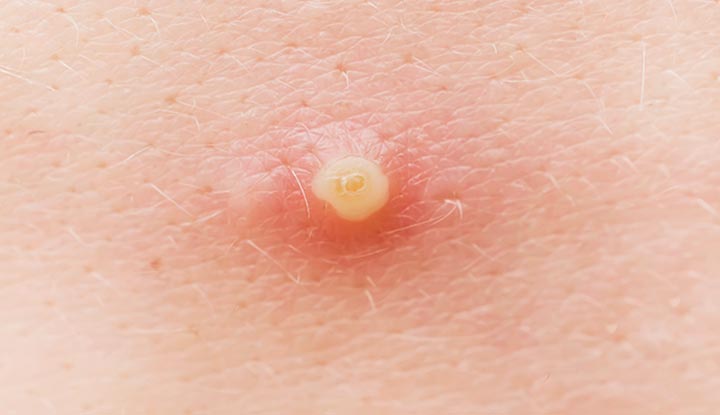An infected pimple happens when bacteria enter your skin, causing pain, redness and swelling. Popping, squeezing or picking at a pimple can lead to infection. You can treat mild infections at home with warm compresses and acne-fighting creams. Some infections require antibiotics. To avoid an infected pimple, never pop zits and keep your skin clean.
Advertisement
Cleveland Clinic is a non-profit academic medical center. Advertising on our site helps support our mission. We do not endorse non-Cleveland Clinic products or services. Policy

A pimple can get infected if you try to “pop” or squeeze it. When you pop a zit, you create an open wound. Bacteria that naturally live on your skin get inside the opening, causing an infection. The area around the pimple may be very sore, red or inflamed. You may also develop a fever.
Advertisement
Cleveland Clinic is a non-profit academic medical center. Advertising on our site helps support our mission. We do not endorse non-Cleveland Clinic products or services. Policy
You can treat mildly infected pimples at home using a warm compress and topical creams. But if the pain or swelling is severe, or if the infected pimple is near your eye, see your healthcare provider. Some infections require prescription antibiotics to kill the bacteria.
To prevent a pimple from getting infected, never try to pop it. Keep the area clean, practice good hygiene and leave the zit alone while it heals.
Anyone can get an infected pimple. But they’re more common among teenagers and young adults who are going through adolescent development (puberty). A pimple can get infected at any age, though. You’re more likely to get an infection if you pop your pimples.
People who have severe types of acne called cystic acne and nodular acne may have a higher risk of getting an infected pimple. These conditions cause painful lumps (sometimes called blind pimples) to form deep below your skin. They may also appear as pimples on the skin’s surface.
If you have rosacea, you may be at an increased risk of infected pimples. Rosacea is a skin condition that causes facial redness and pimples that burn or sting.
In the United States, around 50 million people have acne (the skin condition that causes pimples). Most pimples don’t become infected. Since many people treat infected pimples at home, healthcare providers aren’t sure exactly how many people have infected pimples.
Advertisement
Pimples develop when you have clogged pores. Pores (or hair follicles) are tiny holes in your skin. Dead skin cells, hair, bacteria and sebum (oil your skin produces) can block pores. When oil and skin cells get trapped under your skin, pimples form.
You have hundreds of different types of bacteria that naturally live on your skin. These bacteria aren’t usually harmful or dangerous. But they can cause infection if they get under your skin.
When you pop, squeeze or pick at a zit, you create a break in your skin. This opening allows bacteria to get inside, leading to infection.
Signs of an infected pimple include:
You may be able to recognize signs of an infected pimple on your own. If pain and swelling are severe or you have a pimple that doesn’t go away, see your healthcare provider. You may need to see a dermatologist (a provider who specializes in caring for the skin).
They’ll examine the pimple and ask about your symptoms. Your healthcare provider may take a sample of the pus and send it to a lab to test for infections.
You can treat mild infected pimples at home. Don’t try to pop or drain an infected pimple. Doing so can make it worse or spread the infection. You should:
If you have a lot of pain, the zit is near your eye or the swelling is severe, see your healthcare provider for an evaluation and treatment. You may need prescription antibiotics to kill the bacteria.
You can avoid complications from a pimple infection by keeping the area clean and keeping your hands away from the zit. Most infected pimples get better with good hygiene and antibiotics. But it may take a few weeks for the infection to clear up.
Advertisement
Serious infections and complications from an infected pimple are rare. They include:
You can avoid an infected pimple by:
See your healthcare provider if you have:
Most infected pimples get better with at-home treatments. To reduce pain and swelling, use a warm compress and apply over-the-counter benzoyl peroxide. Keep the area clean and avoid touching the pimple while it heals. Some infections require prescription antibiotics. See your healthcare provider right away if pain and swelling are severe or if the pimple is near your eye. It may be hard to resist the urge to mess with pimples. But you should never pick at, squeeze or try to pop them.
Advertisement
Every day, people see your skin, hair and nails. At Cleveland Clinic, our expert and caring dermatology team will make sure they’re healthy and strong.

Last reviewed on 04/19/2022.
Learn more about the Health Library and our editorial process.